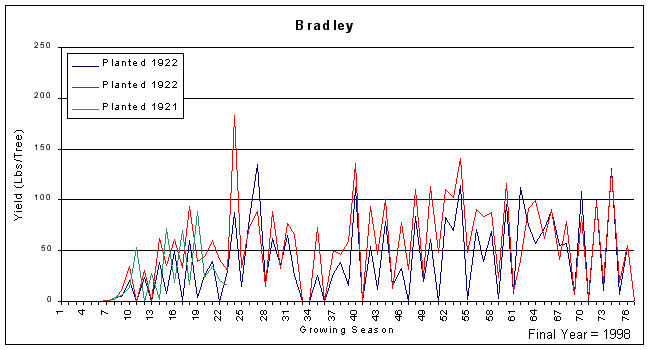Bradley
Average nut quality of test trees.
| # Nuts/ lb. | % Kernel | Kernel quality breakdown | Specific gravity | ||
| % Fancy | % Standard | % Amber | |||
| 70 | 45 % | 8 % | 31 % | 7 % | .78 |
History
The original tree of this variety was grown from a 'Frotscher' pecan planted about 1886 at Macclenny, Fla., by Mr. D.C. Griffing. It bore first in 1892, and its precocity and productiveness, coupled with its early ripening season, caused its owners to begin the propagation of it about 1896. It was catalogued and introduced in 1898 by the Griffing Brothers Company. The original tree has been heavily cut for scions, so that no very accurate determination of its productiveness has been possible, but it is reported to have borne well and regularly up to 1907, when it yielded nearly 200 pounds of nuts.
Comments
*Note: This is an older cultivar planted in the Old Variety Test at the Tifton Campus. Trees were planted decades ago when care was very different than it is now, and trees received much less care, so production data will reflect this fact. Trees began receiving insecticides in 1962, fungicides in 1970, nitrogen in 1962, and drip irrigation in 1975. The data for this cultivar was collected by several individuals, but the bulk of the data and the comments are from my predecessor Dr. Ray Worley. This information was originally published here: Worley and Mullinix, 1997.
A small nut with few redeeming characteristics. Not a recommended cultivar.
Production record of test trees beginning in year planted
'Bradley' production from the Old VarietyTest. Each colored line represents the yearly production in pounds of nuts from an individual tree beginning the year planted.
Alternate Bearing Intensity*= 0.57
*Computed from mature trees using data from years after trees began receiving fertilizer and pesticide sprays.



